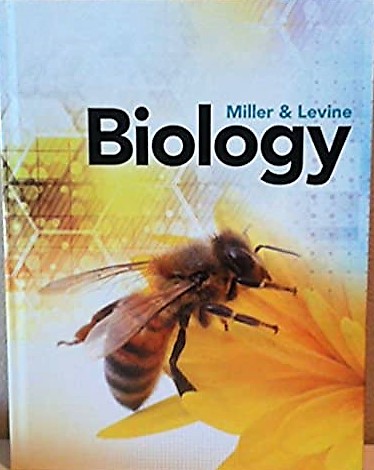
All Solutions
Page 468: Assessment
1. Messenger RNA
2. Ribosomal RNA
3. Transfer RNA
During transcription, an enzyme known as RNA polymerase binds to promoters of the DNA. RNA polymerase then breaks down hydrogen bonds between two strands of the DNA and attaches on one of them. A DNA strand is used as a template for mRNA molecule. A mRNA molecule enters the ribosomes that consist of several types of rRNA and proteins. A tRNA attaches to mRNA molecule. The starting point in the translation process is AUG codon. Based on codons, tRNA with adequate anticodons adds amino acids in order to make polypeptide molecules. The translation process is completed when the stop codon is reached.
A mRNA molecule enters the ribosomes, located in the cytoplasm. In these organelles, a transfer RNA attaches to a mRNA and the process of translation begins. The final product is a polypeptide chain.
Cell specialization means that certain genes are expressed in some types of cells and not the others.
RNA interference is a process in which a miRNA bind to its complementary region on the mRNA and damages it, which stops the transcription.
The table represents codon possibilities for alanine, valine, and leucine.
begin{center}
begin{tabular}{ c c }
AMINO ACID & CODON \
Alanine & GCU, GCC, GCA, GCG \
Valine & GUU, GUC, GUA, GUG \
Leucine & UUA, UUG, CUU, CUC, CUA, CUG \
end{tabular}
end{center}
begin{center}
begin{tabular}{ c c }
AMINO ACID & CODON \
Alanine & GCU, GCC, GCA, GCG \
Valine & GUU, GUC, GUA, GUG \
end{tabular}
end{center}
As we can see from the table above, the first two bases of codons for both alanine and valine are constant, while any one of the four bases could be in the third position. Therefore, substitution mutation in the third nucleotide woudn’t alter the synthesis of alanine, nor valine.
If a mutation occurs during meiotic cell division, that may result in both, functional and defective gametes. If a defective gamete merges with a gamete from the other parent, the mutation is passed on the zygote. However, if a zygote is formed from normal gamete cells, the mutation will not be inherited.
The mutation that occurs during mitotic division of somatic cells can’t be passed on the offspring, because gamete cells aren’t affected by this deviation.
Therefore, we can conclude that both claims are correct.
$text{textcolor{#19804f}{UUU}}$$text{textcolor{#4257b2}{AAC}}$$text{textcolor{#19804f}{UGU}}$$text{textcolor{#4257b2}{UCU}}$$text{textcolor{#19804f}{GUC}}$$text{textcolor{#c34632}{UAG}}$AG
$text{textcolor{#19804f}{Phenylalanine}}$-$text{textcolor{#4257b2}{Asparagine}}$-$text{textcolor{#19804f}{Cystein}}$-$text{textcolor{#4257b2}{Serine}}$-$text{textcolor{#19804f}{Valine}}$-$text{textcolor{#c34632}{Stop Codon}}$
If a nucleotide is added right before the begining of the sequence, the codons will be completely changed into:
$text{textcolor{#19804f}{AUU}}$$text{textcolor{#c34632}{UAA}}$CUGUUCUGUCUAGAG
$text{textcolor{#19804f}{Isoleucine}}$-$text{textcolor{#c34632}{Stop Codon}}$
If the first nucleotide is deleted, the sequence will be:
$text{textcolor{#19804f}{UUA}}$$text{textcolor{#4257b2}{ACU}}$$text{textcolor{#19804f}{GUU}}$$text{textcolor{#4257b2}{CUG}}$$text{textcolor{#19804f}{UCU}}$$text{textcolor{#4257b2}{AGA}}$G
$text{textcolor{#19804f}{Leucine}}$-$text{textcolor{#4257b2}{Threonine}}$-$text{textcolor{#19804f}{Valine}}$-$text{textcolor{#4257b2}{Leucine}}$-$text{textcolor{#19804f}{Serine}}$-$text{textcolor{#4257b2}{Arginine}}$
G = 17,5%
C = 17,6%
A + U + G + C = 100%
A + U = 100% – 17,5% – 17,6%
A + U = 64,9%
A = U = 32,45%
The percentage of adenine, as well as uracil, is approximately 32%.
Based on the values of cytosine and guanine we can assume that the viruses A and B probably have a double-stranded RNA molecule. In a double-stranded RNA molecule the percentage of adenine and uracil, as well as guanine and cytosine, is almost the same because these bases are complementary. However, values of adenine and uracil differ in virus C and virus D has an RNA molecule in which there is a difference in the percentage of guanine and cytosine. We can conclude that these two viruses probably contain single-stranded RNA molecules.
Various cells that make the same tissue have similar gene expression patterns. However, if certain factors are able to induce disease and alter the expression of genes, the knowledge of epigenetics can serve us for diagnostic purposes. The expression patterns of cancer cells can tell us about their origin, which is crucial for establishing the stage of cancer and choosing the right therapy treatment.

